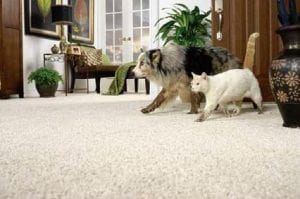How to Clean Carpeted Areas and Upholstery
 For “New” Stains:
For “New” Stains:
Soak up as much of the urine as possible with a combination of newspaper and paper towels. The more fresh urine you can remove before it dries, especially from carpet, the easier it will be to remove the odor. Place a thick layer of paper towels on the wet spot, and cover that with a thick layer of newspaper. If possible, put newspaper under the soiled area as well. Stand on this padding for about a minute. Remove the padding, and repeat the process until the area is barely damp.
If possible, put the fresh, urine-soaked paper towel in the area where it belongs—your cat’s litter box or your dog’s designated outdoor “bathroom area.” This will help remind your pet that eliminating isn’t a “bad” behavior as long as it’s done in the right place.
Rinse the “accident zone” thoroughly with clean, cool water. After rinsing, remove as much of the water as possible by blotting or by using a wet vac.
For Stains That Have Already Set:
Consider renting an extractor or wet vac to remove all traces of heavy stains in carpeting (get one from a local hardware store). This machine works much like a vacuum cleaner and is efficient and economical. Extracting/wet vac machines do the best job of forcing clean water through your carpet and then forcing the dirty water back out. When you use these machines or cleaners, carefully follow the instructions. Don’t use any chemicals with these machines; they work much better with plain water.
Use a high-quality pet odor neutralizer once the area is really clean (available at pet supply stores). Be sure to read and follow the cleaner’s directions for use, including testing the cleaner on a small, hidden portion of fabric first to be sure it doesn’t stain.
Try any good carpet stain remover if the area still looks stained after it’s completely dry from extracting and neutralizing.
Avoid using steam cleaners to clean urine odors from carpet or upholstery. The heat will permanently set the stain and the odor by bonding the protein into any man-made fibers.
Avoid using cleaning chemicals, especially those with strong odors such as ammonia or vinegar. From your pet’s perspective, these don’t effectively eliminate or cover the urine odor and may actually encourage your pet to reinforce the urine scent mark in that area.
Neutralizing cleaners won’t work until you’ve rinsed every trace of the old cleaner from the carpet if you’ve previously used cleaners or chemicals of any kind on the area. Even if you haven’t used chemicals recently, any trace of a non-protein-based substance will weaken the effect of the enzymatic cleaner. The cleaner will use up its “energy” on the old cleaners, instead of on the protein stains you want removed.
Your job will be more difficult if urine has soaked down into the padding underneath your carpet. In some cases, you may need to take the drastic step of removing and replacing that portion of the carpet and padding.
